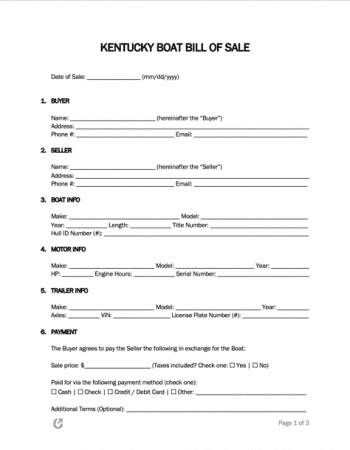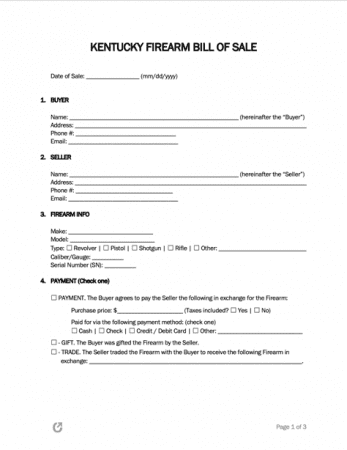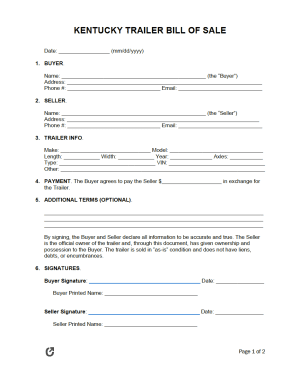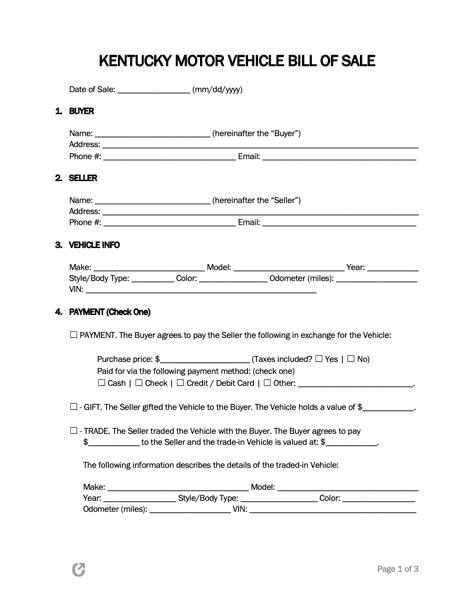Kentucky Bill of Sale Forms (5)
A Kentucky bill of sale form accredits the named person as the official possessor of an item, thereby releasing the seller from ownership. Both parties discuss the document’s contents, ensuring that they have provided accurate information about themselves and the property. Once they agree on the terms, each person signs to note their approval.
Summary
|
Types (5)
 Boat Bill of Sale – A formal receipt outlining how and when a buyer purchased a vessel from a seller.
Boat Bill of Sale – A formal receipt outlining how and when a buyer purchased a vessel from a seller.
 Firearm Bill of Sale – Provides a summary of a gun sale and both parties involved in the exchange.
Firearm Bill of Sale – Provides a summary of a gun sale and both parties involved in the exchange.
 General Bill of Sale – Certifies ownership over an item that does not fall into a definite category.
General Bill of Sale – Certifies ownership over an item that does not fall into a definite category.
|
 Trailer Bill of Sale – For selling a utility trailer from one party to another.
Trailer Bill of Sale – For selling a utility trailer from one party to another.
Signing Requirements
| Bill of Sale Type | Buyer Signature | Seller Signature | Notarization |
| Boat | Required | Required | Not required |
| Firearm | Required | Required | Not required |
| General (others) | Required | Required | Not required |
| Motor Vehicle | Required | Required | Not required |
| Trailer | Required | Required | Not required |
What is a Kentucky Bill of Sale?
A Kentucky bill of sale releases the seller from ownership and bestows the responsibilities onto the new owner. By claiming the item, the buyer agrees to take care of legal obligations and payments incurred for repairs, taxes, or other relevant matters. The purchaser cannot demand compensation or reimbursement from the seller, even if something breaks or becomes damaged after the transaction.
The owner can use a bill of sale to obtain a title and registration for a motor vehicle or boat. In addition, they can reference it to see the odometer reading or value at the time of the sale. Each person should retain a copy of the form following the sale as proof of purchase. The new owner may also need it if they decide to sell the item again.
Registration Forms: Boats
County clerks accept vessel registration applications and fees in Kentucky.
|
Additional (Optional) Documents
- Application for HIN (Form TC 96-169) – A form needed to apply for a HIN. The owner must present a notarized document that proves ownership (i.e., a title, bill of sale, registration, affidavit, or order from the court).
- Manufacturer’s Certificate of Origin (MCO) – Owners of brand new boats must present this form to the county clerk.
Registration Forms: Firearms
Kentucky residents do not need to undergo gun registration. Individuals wanting a concealed carry license must follow the instructions for registering at a county sheriff’s office or online.
|
Additional (Optional) Documents
- Carry Concealed Deadly Weapons Licensee Request for Change of Personal Information (Form KSP 121) – To make corrections, such as an address or name change, to an existing concealed carry license.
- Citizenship Affidavit (Form KSP 131) – For non-U.S. citizen applicants only.
- Request for Duplicate (KSP 126) – License holders complete this form to replace lost, stolen, or damaged permits.
Registration Forms: Vehicles
Registrars must locate their nearest county clerk to provide the documents needed for car registration.
|
Additional (Optional) Documents
- Application for Vehicle Identification Number (VIN) (Form TC 96-169) – A document used to apply for a VIN.
- Kentucky Motor Vehicle Power of Attorney (Form TC 96-336) – A form only utilized when the owner wants another person to carry out their vehicle obligations.
- Road Usage Tax – The applicant must prove that they paid taxes (at a 6% rate) upon purchasing a new vehicle.
- Vehicle Inspection – The state requires a vehicle inspection if the owner previously registered or titled the car in another state. Since each county has specific inspection policies, residents should defer to their local office to learn more.
Registration Forms: Trailers
Kentucky requires titling of all trailers in the state; however, it only mandates registration for commercial use trailers. Residents who privately own and operate their trailers do not need a registration. Regardless of the need, buyers and sellers should always use a bill of sale form to obtain proof of purchase.
How to Write
Step 1 – Today’s Date
At the top of the form, enter the date of completion. More often than not, this should be the current (today’s) date.
Step 2 – Buyer & Seller Info
For both the buyer and seller, each person will need to enter the following information (* = optional):
- Name
- Address (should include any unit or apt number, city, state, and ZIP)
- Phone Number*
- Email*
Step 3 – Vehicle Info
The form must contain a sufficient description of the vehicle to identify it easily. The person writing the form needs to present a description of the car and include the following:
- Make (e.g., Ford, Lotus)
- Model (e.g., F-150, Elise)
- Year (e.g., 2025)
- Body type or style (e.g., 4 dr, coupe, XLT)
- Color (exterior)
- Odometer (miles)
- VIN (17 digits)
Step 4 – Payment
There are three (3) payment options provided on the form. The document’s writer will need to select just one (1) of the displayed options, which include:
- Payment – This is the standard option. Involves the buyer making a direct payment to the seller via cash, credit, check, or a bank transfer.
- Gift – Used if the seller is gifting the motor vehicle to another person (such as a family or friend).
- Trade – Both parties should complete this section if the seller will be receiving a vehicle in return from the buyer for their car. Here, the seller can list the value of the trade-in vehicle and the amount the buyer is paying (if any) to the seller.
Step 5 – Additional Terms
This section is optional and allows the parties to add any custom language to the document if they feel necessary.
Step 6 – Signatures
At the end of the document, the buyer and seller must sign, date, and print their name on the form.
Step 7 – Notarization
This section is optional and provides the parties with additional proof that they signed the form. If the parties are notarizing the document, they will need to wait to sign until directed by a Notary Public.

